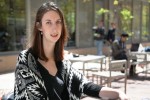Laura Alsum struggled through writing sections of what would become her award-winning screenplay not as a result of a creative block, but because of the painful memories that resurfaced.
Born with a congenital muscle disease that weakens her ability to move, Alsum shares many of the struggles of her screenplay’s main character.
“My screenplay was personal, so it was hard to write some scenes because of what had happened to me, making me emotional at times,” Alsum said. “It brings back a lot of experiences I had with my parents and teachers.”
Alsum, a graduate student in screenwriting at the UCLA School of Theater, Film and Television, is the 2014 recipient of the Alfred P. Sloan Foundation Student Grand Jury Prize for Screenwriting for her screenplay “Survival of the Fittest,” which chronicles the story of 12-year-old Charlie, a star athlete who develops progressive muscular dystrophy and can no longer play baseball. This prompts him to enter a science fair, proving he is still capable of fitting in at school.
The Sloan Prize is awarded to screenplays that explore issues of science or technology, and includes a $30,000 cash prize as well as an additional $20,000 to help develop the screenplay into a film. Winners are then invited to the Tribeca Film Festival in late April and mentored by industry professionals.
Blending aspects of evolutionary biology and medicine, “Survival of the Fittest” showcases Charlie’s adaptation to his disease as he copes with physical and mental stresses.
“We’re all thrown curveballs in life that we don’t expect or like at first, and I think that is part of life,” Alsum said.
In order to accurately represent scientific facts in the story, Alsum was paired with Jessica Lynch Alfaro, the associate director of the UCLA Institute for Society and Genetics. Alfaro said she introduced Alsum to theory and research in her own field of study, helping her weave science accurately into the story.
“Alsum was able to layer her screenplay with science in many ways, such as Charlie discovering the biology of his disease, and the roles of science in schools and (with) religion,” Alfaro said.
Alsum said that while she was originally unfamiliar with the science behind Charlie’s disorder, she relates very well to his emotional response. Charlie rejects restrictions his parents and teachers impose on him, something Alsum also faced in grade school.
Fearing that Alsum would fall and hurt herself while walking around school, her principal requested she always ride in a wheelchair. Alsum said she opposed these knee-jerk reactions because she believed she was responsible enough to decide her own limitations.
Eventually, people in Charlie’s life realize that he knows what works best for himself. Alsum’s screenwriting professor and mentor Hal Ackerman said that Alsum’s ability to pull from her personal experiences gave “Survival of the Fittest” clarity and sensitivity.
“The story could have been overly sentimental because it can be difficult for young writers to make their stories emotional,” Ackerman said. “(Alsum) was able to do this by drawing from her life and giving insight to her character.
One of the central themes in “Survival of the Fittest” is resilience, with Charlie shifting his productive energies from baseball to the science fair.
Although she admits that she did not face the same tribulations as Charlie, Alsum said that, like him, she learned to focus on what she could do rather than her weaknesses. Unable to compete in sports, Alsum said she adapted by focusing on her strengths: the arts and writing.
“I have always been interested in observing people and using my observations to tell human stories,” Alsum said. “You realize what you’re good at and you find ways to make it work.”
Alsum said the main message behind “Survival of the Fittest” is that change is a normal and important occurrence in life, but it is essential to learn and adjust.
“People may see my disability as an abnormality, but genetic mutations happen in nature all the time and it’s another normal part of humanity,” Alsum said. “Bad things do happen, but the big question is, what are you going to do?”
